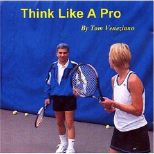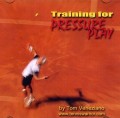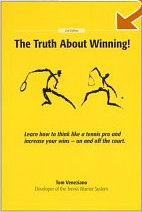Glenn, a teaching pro at the club where I work, has watched me teach my system for years. Curious, he came up to me one day and asked in a sarcastic but humorous tone, "Let me get this straight. You tell your players to keep botching up until they no longer botch up?" While laughing in agreement, I replied that although his description of my methods is a simplistic version of how I actually teach, there is some truth to it. In order to learn you must make thousands and thousands of mistakes. You must be able to cope with these mistakes and stay with the process of learning. This process for learning requires a never-ending flow of balls that you must hit day after day, month after month, year after year! Remember, repetition is the chariot of genius.
Learning with and staying with repetition is much more productive than whining about the myriad of failures, adversities and complications that most players focus on. Learning "the next shot is more important than the last mistake" takes time and much repetition. Letting this process teach you to play more automatic, spontaneous and instinctive tennis requires a lot of patience and perseverance.
THE PROCESS VS. WHAT PLAYERS WANT
I thought more about how to expand Glenn's phrase to fit with my teaching methods. I place a high priority on teaching players to handle their failures. And to accomplish this, they must learn to stay out of their own way. Strange, isn't it? You must stay out of your own way to help you learn and improve! This is one of the reasons I love teaching. There are always unique twists and turns to the learning process!
What do I mean "stay out of your own way?" I mean you should not let your failures keep you from forging forward in repetition, repetition, repetition.
What players want is the perfect stroke today, right now, this minute. They do not understand the learning process which requires long hours of repetition. They think that since they have been practicing for two or three months they should now have a perfect stroke. They hit a thousand balls in three months. They think, "What more can they do?" Now, this is where they stand in their own way by getting mad at their failures and frustrated at the lack of progress. They stop the natural learning process and force the stroke to make it happen. Alert! Alert! It's not going to happen!
You are now firmly standing in the way of the process. Frustration increases. You become confused. What in the world should you do? Answer: Get out of the way and keep the process going!
Because this is such a huge problem, I encourage you to stand firm in the process of repetition, repetition, repetition. But I must be honest with you and explain again what it really takes. Stay objective. Do not become discouraged. Do not be overwhelmed. Come with me and I will show you the Elysian fields - a state of mind of tranquility and contentment - with your own game.
I received an email from a father who thanked me for lucidly explaining how much repetition it takes to really develop confidence in a stroke and in a player's game. He said his daughter now knows what has to be done and is much more relaxed about her game and her failures. I guess you can say she has learned to "keep botching up until she no longer botches up!" She is learning at a young age to stay out of her own way and to trust the process. This unique focus must be instilled in the long-term memory of all players.
Do you understand all that you are trying to accomplish when you attempt to hit a tennis ball? Picture this. You are trying to hit a small, round, moving ball into the tiny sweet spot of a moving racket, all while you are moving. To make matters worse, you must hit this little two-ounce moving ball with the tiny sweet spot of your moving racket into a 39 by 27 foot boundary while you are moving. And there's more! You must figure out what direction this little moving ball will be coming from after your opponent hits his or her shot! The only bright side is that the court is not moving. (Although at times I'm sure it feels like it is!) The bottom line is, accomplishing this feat takes laser precision.
Actually the amazing feat is that we hit the ball at all! Do you still think after two or three months of practice and a thousand hits you should own the stroke? Do you think your body can calculate that quickly and find this small moving ball with a moving racket while you are moving and hit the ball into a specific target?
THE CORRECT PERSPECTIVE
As I begin training pros, I always make sure they understand that hitting five thousand balls is not much. I quickly orient them to the reality of what must be done to accomplish their goals. Players think I'm exaggerating when I tell them that five thousand hits is not much when developing a top notch game, but believe me, this is NOT an exaggeration. In the last month I have had one pro hit six thousand backhands.
You too must learn to think in the same way. Now, I do not expect most of you to go out and hit as many balls as a pro would. It's the principle of repetition that is vital. Each week, if you consistently add a hundred or more extra hits of a particular stroke, you will eventually find yourself head and shoulders above everyone else. Remember to 'stay out of your own way' and keep the process going week after week after week. Eight months later I would expect to find you doing the same routine. You can use a ball machine or have a friend feed you balls. But do not stop!
Will you make mistakes and have many ups and downs? Absolutely! Use your failures to develop mental toughness and keep the learning process going. No one can learn anything about anything without failures. 'Stay out of your own way' and trust the process. Learn to "botch up until you no longer botch up!" You know, that phrase is kind of growing on me. Thanks Glenn!










 You will join 13,000 other subscribers in receiving news of updates to the Tennis Server along with monthly tennis tips from tennis pro Tom Veneziano.
You will join 13,000 other subscribers in receiving news of updates to the Tennis Server along with monthly tennis tips from tennis pro Tom Veneziano. 